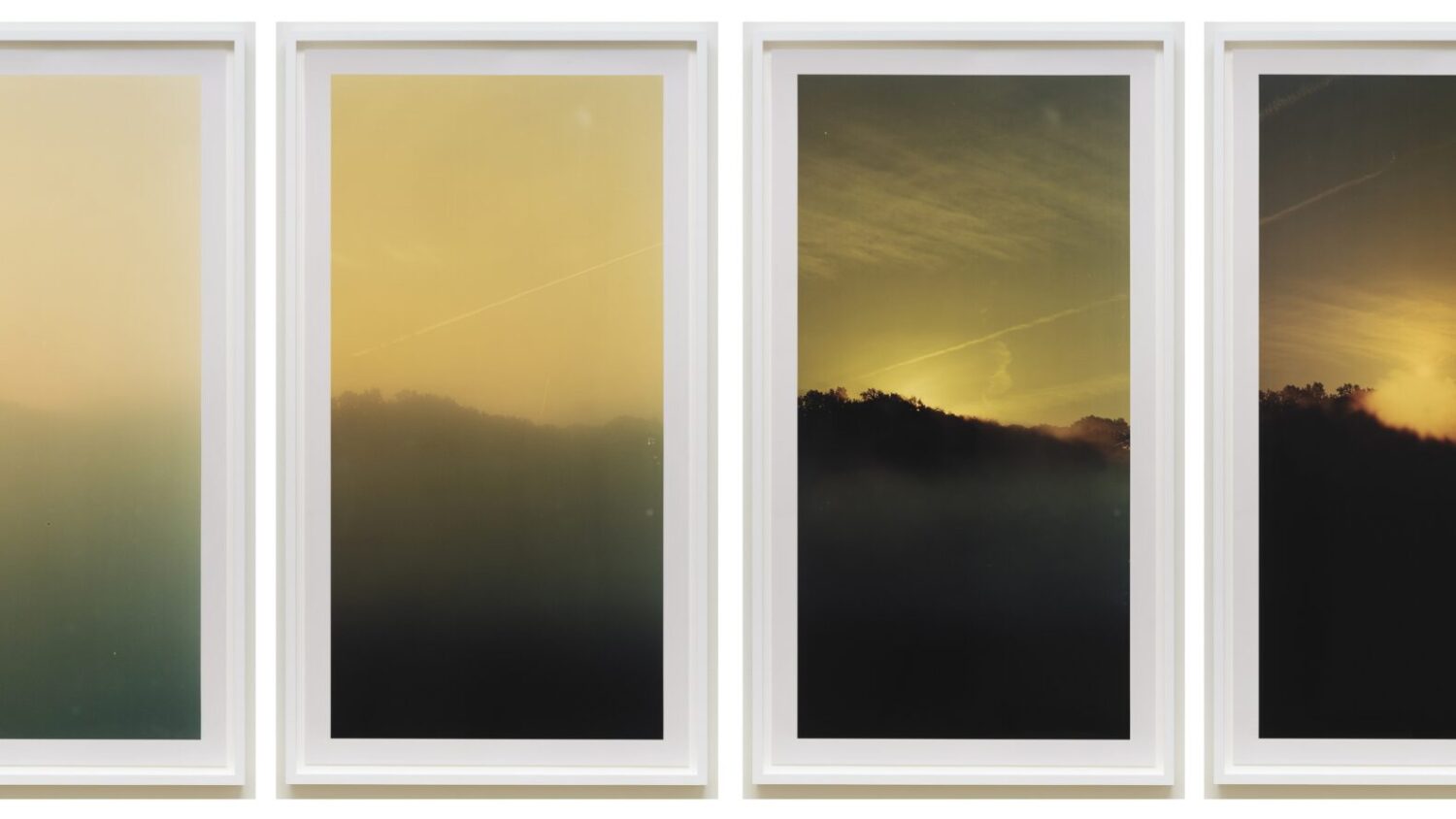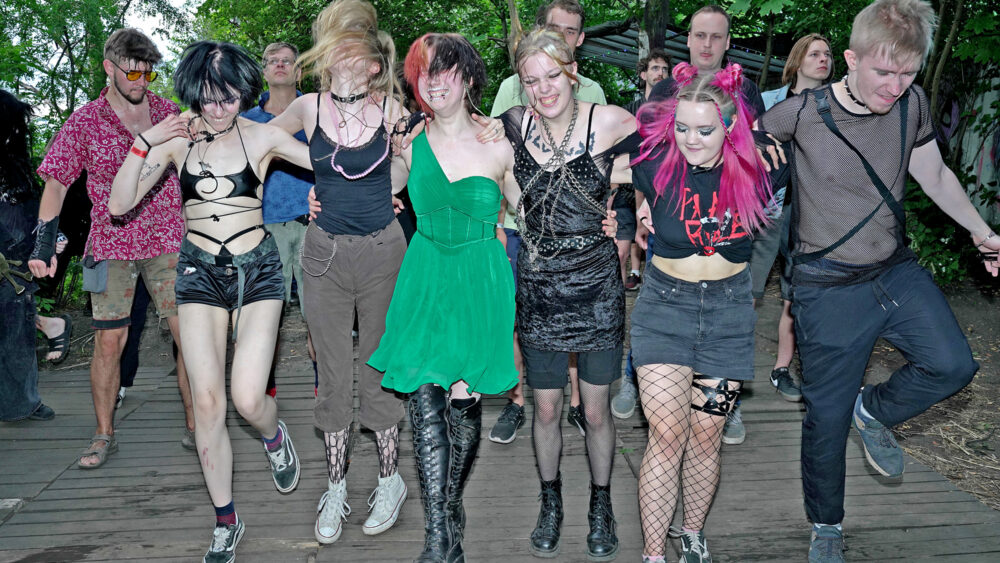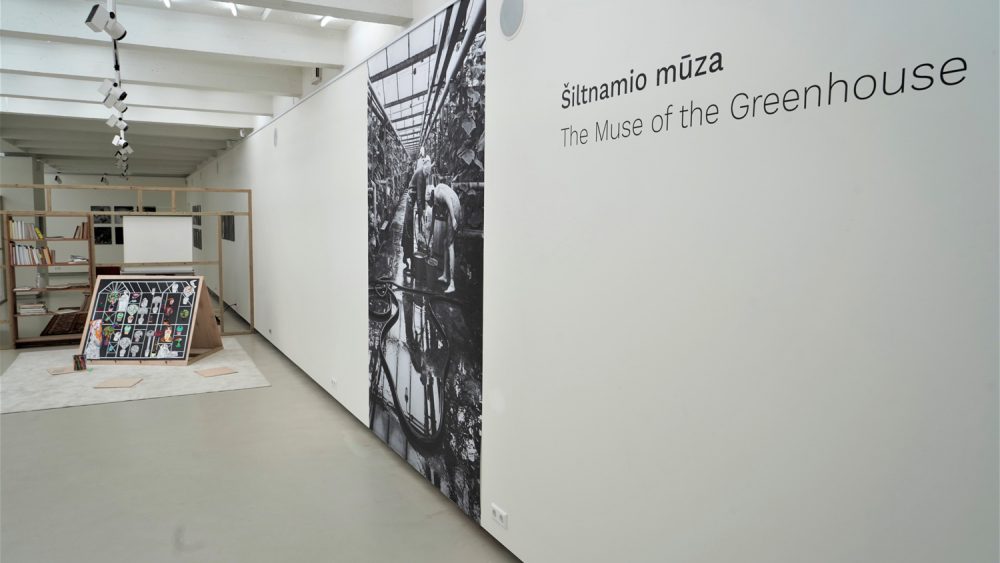Through landscape. Interview with Paul Kuimet
The exhibition Landscape Passes Through the House by Paul Kuimet and Tõnis Saadoja is on at the Tartu Art Museum until August 27. It questions whether it is possible to experience landscape through art and in what ways. Conceptually interesting, the exhibition also includes pieces from the collection of the Tartu Art Museum and the Art Museum of Estonia that are not used but cannot be discarded, adding a layer of naïve art.
Paul Kuimet (1984) is Estonian artist who mostly works with photography and film, focusing on capitalism, social and cultural values, as well as the opportunities of the analogue and the use of light in the artwork. Kuimet has received an MA degree from the Estonian Academy of Arts (2014). In 2018, he participated in the residency programmes at the WIELS Contemporary Art Centre, Brussels and at the International Studio & Curatorial Program (ISCP) in New York City. Since 2022 Kuimet has been the Visiting Associate Professor at the Estonian Academy of Arts, Department of Photography.
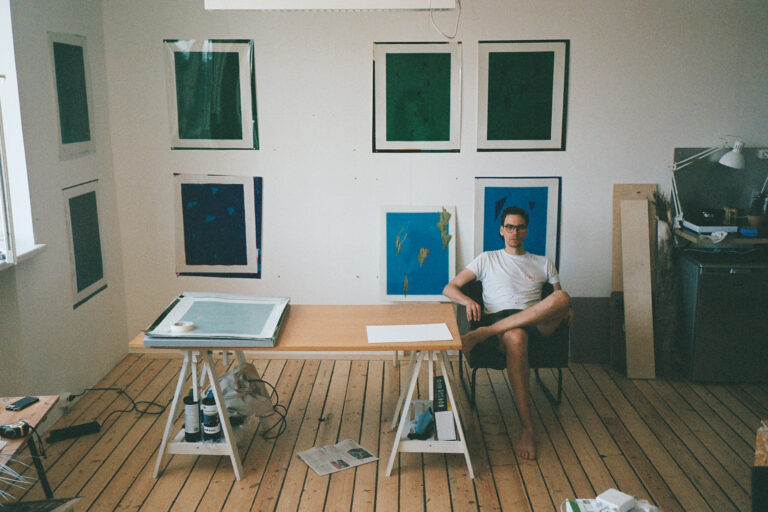
How did you find your path in photography? You work in either an analogue or a camera-less way. What interests you in these methods particularly?
When I was younger, I was quite an avid skateboarder and what comes with that subculture is the notion of videographing and photographing one’s friends, and I was quite obsessed with that. It was more often than not that I had the video camera in my hands. I realized that I enjoyed it a little bit and that I was pretty good at it, or at least I could imitate what I saw in the professional videos. When it came time to think of a higher education degree, I decided to go and study film. I did it for a year in England and then a year in Tallinn, but I didn’t really enjoy it that much somehow. Filmmaking or feature filmmaking is a collaborative effort and at that moment in my life it felt somehow uncomfortable. I had also started taking some photographs around that time and then I decided to try to apply to the Estonian Academy of Arts, and then it kind of rolled from there, I would say.
When I started, about 15 years ago, the digital equipment was not that good, film was still better. When the digital got better, I just kept shooting film because I was used to it. From 2008 to 2019, I was shooting film but always printing digital. In the last five years I got a little bit tired of the fact that I would shoot film and then I would scan it and it would still be information on the computer. I felt I did not have enough of a material connection to my work and I wanted to be more hands on, let’s say. Around this time, the color processor got started up again at the Department of Photography at the EKA and I just started working there quite intensively and learned a little bit more about printing myself.

photocollage, C-print on aluminium composite, epoxy resin, each 47.5 × 47.5 cm
Is analogue more like a habit or is there any philosophical idea attached to it?
When conceiving the series of photocollages called Crystal Grid, I was indeed thinking about the indexicality of photography, the notion of light falling onto the negative and remaining there photochemically, and some of that captured light still being present when the images get printed later on. The collages present fragments of plants, which in reality are perhaps thousands of kilometers apart, yet in this work they are brought onto the same image plane in the most physical way possible – for which analogue photography seemed the only viable solution.
And with What It Is To Be What You Are Not, a series of assemblages, I also wanted to work with “real” materials and not data from the computer. In my thinking about the work, I looked towards materialist film theory by Peter Gidal and others – theorists and filmmakers who in the 1960s and 1970s advocated for anti-illusionist cinema. So, in creating those luminograms with actual leaves, and not representations of leaves, it was equally relevant that it was a real physical light and its colour that created the images. And I suppose that goes for the works in the exhibition at the Tartu Art Museum too.
Can you talk about your process? Is it thinking, sketching, writing? How do you work?
It’s a little bit different for each work. For example, for Crystal Grid, it was a good 4-5 years of thinking about the Crystal Palace – this building that was built in 1851 for the first World Exhibition or what later became known as the World Expo and that my film Material Aspects looks at.
That building burned down in 1936, so there was no way to photograph it but what I could see that its architecture was very similar to the architecture of botanical gardens that were built in the 19th century.
What I ended up doing was going to different botanical gardens in the world and I ended up photographing the plants in the buildings more than the architecture itself. To bring these things together I developed a collage pattern that is based on the roof of the central transept of the Crystal Palace and then use this collage pattern to evoke the image of the Crystal Palace, as if it’s still haunting these plants, a ghost grid if you will. I started shooting for that series in 2018, a year during which I happened to be traveling a little bit more than usual. In 2020 I presented the first collages, and this series is still ongoing.
As for the exhibition Landscape Passes Through the House the process was quite different. The curator Eero Epner and Tõnis Saadoja, the other contemporary artist in the exhibition, approached me. The rest of the process was very intuitive and fast. We went from the invitation to the exhibition to its opening in less than one year, and given that it was all new work made for that show, it was very fast, and thus a completely different working process.

The exhibition Landscape Passes Through the House asks if it’s possible to talk about experiencing landscapes through art and in what ways? Is it actual experiencing? What is your own answer to that?
That was written by the curator Eero Epner, so it’s best to ask him, but of course I can give some idea of what we were thinking about when the three of us were talking about the exhibition.
First, we were looking at the almost forgotten pieces that are in the collections at the Tartu Art Museum and the Art Museum of Estonia. Many of the pieces in the exhibition are not in the permanent collections of these museums, but they are part of something that is called like a side collection. So, they are pieces that came to the museum maybe through donations together with more accomplished works. Consequently, they are not finished works as such, but they are also not pieces that you can just deaccession. So, it was a lot of sketches on poor materials like pieces of plywood, paper and even transparent plastic. The poverty of the materials, motifs and techniques was something of interest to us. Mainly because, I think that these pieces projected some sort of inner monologue of the artist with the landscape, as opposed to the landscape being depicted grandly for it to be later seen by an actual audience.
From this perhaps we can arrive at the question you mentioned, whether it is possible in 2023, to look at landscape without any overt ideological sentiment, and if it’s possible to look at landscape not in relation to the Anthropocene and the climate crisis, but as something possible of evoking more like an emotional state of mind.
Landscape Passes Through the House is so far the most representative series of nature. Crystal Grid and What It Is To Be What You Are Not are more abstract, more geometrical. How did you arrive at this transition?
I don’t know if it’s really a transition yet. I don’t really have an answer for that at this point. It seemed like I could make such works for this exhibition, some of them kind of very straightforward and in that sense quite old fashioned. Some of the pieces however, like Small Oak 1-3 and Untitled 1-4, also included a direct manipulation with light. I would say that I continued making an abstract layer on top of the landscapes because I was still somewhat skeptical of presenting only straight documentary photos. But then again, many of the smaller pieces in the show were completely unmanipulated.

It seems like you’re trying to make nature more regular through your images that are either similar in composition or seem to be taken seconds apart.
I would argue that I am making a completely opposite proposal. Meaning that, by using seriality or images taken from the same point of view, but at different times, I am showing that each moment, each light condition and indeed, each leaf – is completely unique. Humankind’s attempt to gain control over nature, pictorially or otherwise, is a futile attempt, a fool’s errand. Much of modernity revolved around this supposed separation between nature and culture, but only now we are beginning to see it as a mistake.
You emphasize the beholder’s importance or acknowledge their presence and that they come with their perception and leave with their impressions. How is the viewer important for you?
Starting from 2013, I made a series of lightbox installations that were always shown in completely darkened spaces, the architecture of which I also always designed. So, the viewer would enter the space and because there was no light in the room apart from the lightbox itself, it was very dark and disorienting. Yet slowly, as the eyes of the beholder adjusted, they would be able to move around and continue to the other images and recognize their relation to one another. Thus, it was very important to guide the viewers’ body and gaze in space and their relationship to the images.
However, when I worked with the moving image, I would often work a little bit the opposite way. I would always try to avoid the black box because I felt it’s just a shitty version of cinema built into the gallery, the sound and seating always being subpar and so on. So I always tried to make my films to be presented as installations. I would often use double sided screens of specific sizes and in specific positions, so as to make the viewer more like an active participant, rather than a physically passive viewer, which is what happens in a cinema.
But I do have to say that some of my photographic work in recent years has been much more conventional, often modestly sized and hung on a wall, nicely framed.
Untitled (Main Hall) seems to be the first work where you introduce two of your subjects – architecture and plants – in the same space. And through a very interesting concept. Can you talk about how you came up with this idea?
I was making these lightbox installations as I described before, and then at one point, I had an idea that perhaps I could do an installation like this. However, instead of using lightboxes with an artificial light, I would use a natural light. I imagined that if the natural light was changing, then the images would also be changing, according to the amount of light and the direction of light. For this, I needed a space that had a lot of diffused natural light. The main hall of the Tallinn Art Hall, built in the early 1930s, has a very classical European kunsthalle architecture with the glass ceiling, so it seemed appropriate for that piece. I designed an inverted lightbox in the middle of that space. When you enter the main hall, you see the scaffolding of the walls and the bare wall structures, and then you see the lightbox images from the flipside. When you enter this space, you see the images from their correct side and they are being lit by the natural light that falls into the hall from the skylight above. This was a work made in conjunction with the film Material Aspects and Crystal Grid. In that work, I also use the images from botanical gardens that I shot in Gent and Glasgow. What I liked about the piece was that in March when we opened the show, there was not a whole lot of natural light yet, but towards the end of the show in May, it was very bright, and the work did indeed change during that period.
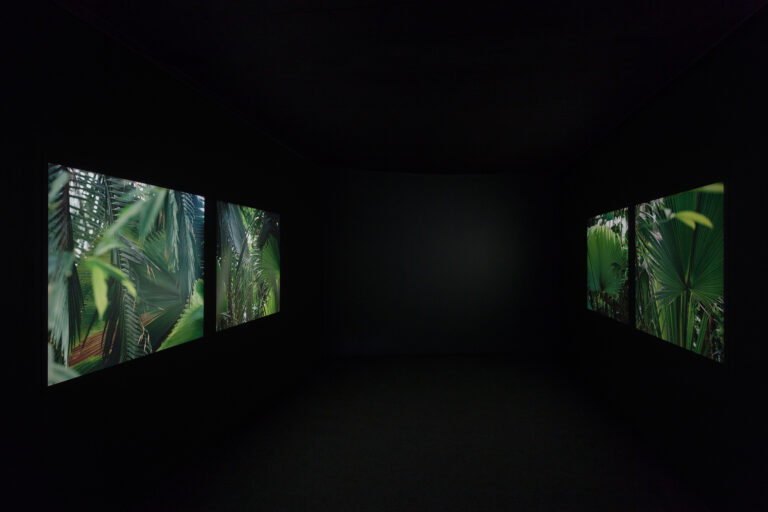
When you work with these 2 subjects, one might think that they are your objects of interest, but are they really?
I think they are not really objects of my interest, but more like means to an end, devices, forms or materials to address cultural, industrial and economic production since the mid-19th century. Similarly, in my collage work I am not interested in what kind of plants they are specifically, but rather about the fact that they are mainly exotic plants brought to the West during the colonial period.
Why is contemporary art and photography still so separated?
I don’t personally feel that way. Although I work in a rather medium specific way, I see my work as part of the discourse of contemporary art, and I’m not sure my work has that much of a presence in the photography scene.
But I do see, that if events and exhibitions start to get labelled partly by any one medium, then there is the threat of falling into a kind of ghetto. I do feel, for example, that because Tallinn Photomonth is called “a photomonth”, as opposed to, say a biennale of contemporary art, it has been somewhat ignored by some part of the art world, despite it being the biggest contemporary art biennial in Tallinn. But by the same token, I am not that interested in going to some annual painting exhibitions, because I have similar prejudice about that kind of medium specificity.
How much do you think art is local and how much is it universal?
I really have to think about that. Generally, I think the Baltics have caught up with the West, in the sense that artists are making work here like anywhere else. Whereas in the 1990s, maybe curators from the West were little bit more actively looking around to find, you know “wild artists” from the East, that were untainted, or had responded differently to the history of art since World War II. That is of course a colonial and exoticizing gaze which, as I’ve recently experienced, much of the West still does not recognize.
Nevertheless, this particular interest has evaporated, and now people are making work here, like everywhere else, so this exoticizing gaze has been replaced by utter ignorance in many cases. We’ll have to see if anything changes after the war in Ukraine. I hear that museums in the West are only now adjusting labels and artists’ nationalities from Russian to Ukrainian. That is all good, it is just so incredibly sad that it takes over a hundred thousand casualties on the Ukrainian side for this to happen. So as much as I’d like to believe that the experience of art is universal, I think the institutions that make the experiencing of art possible in the first place, are still very local and narrow-minded in many ways.
